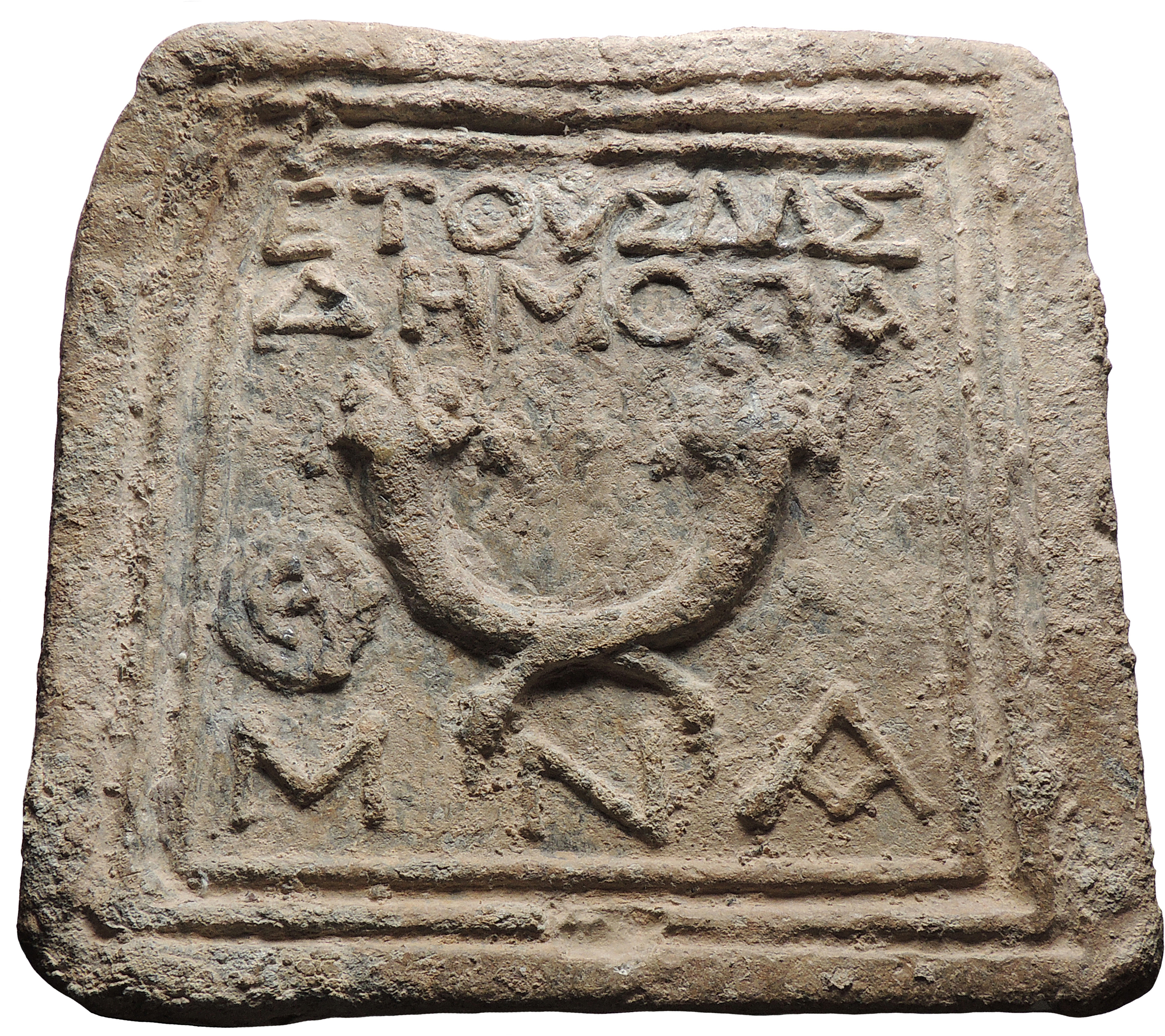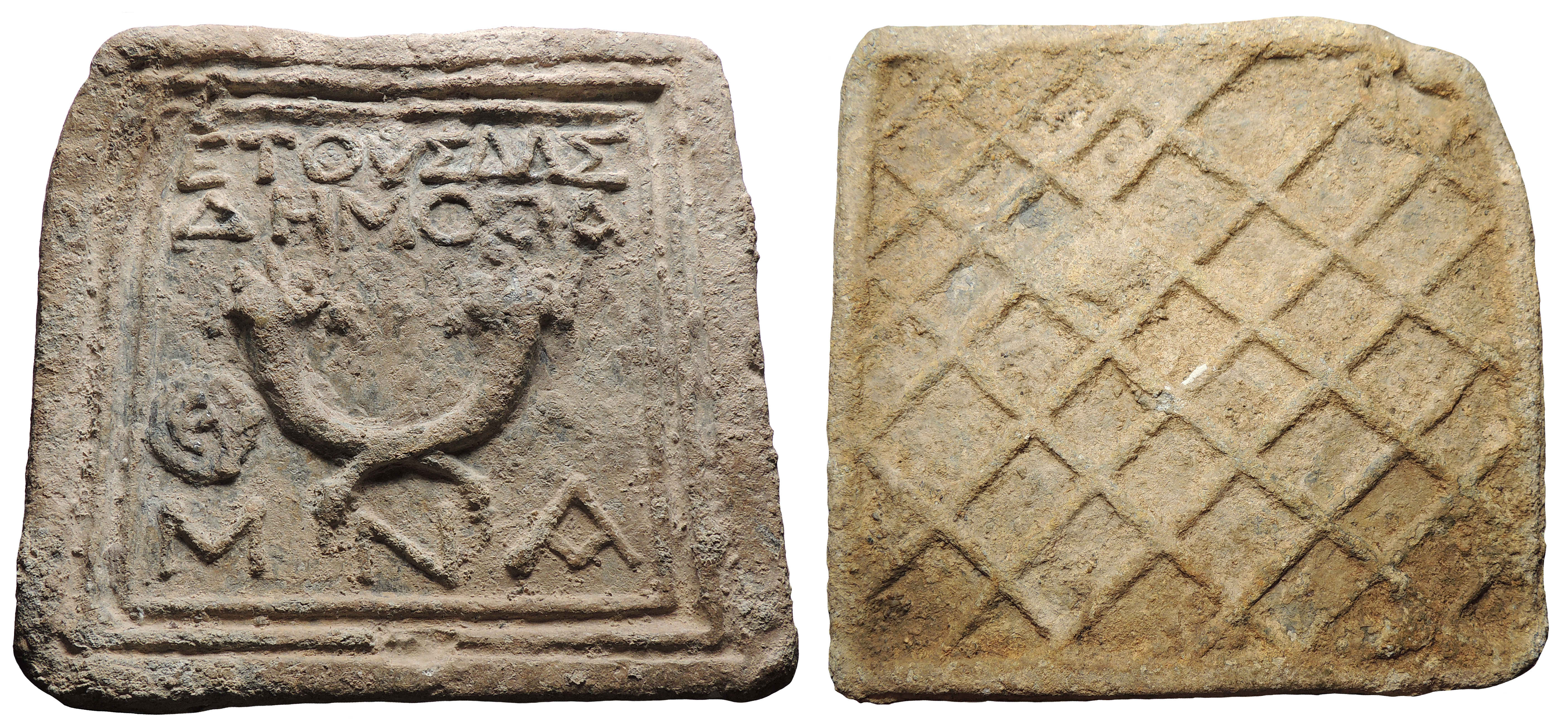
-
Copyright credit: Tekin 2024

-
Copyright credit: Tekin 2024

-
Copyright credit: Tekin 2024

ARCHAEOLOGICAL DESCRIPTION OF THE WEIGHT
Authority
{Illegible monogram}, agoranomos (Antioch)
Mint
Antioch
Denomination
1 Mina
Material
Lead
Manufacture
Cast
Shape
Square
Length
11.00 cm
Width
10.60 cm
Height
0.90 cm
Metrology
| Mass (g) | Mass (grain) | Date of measurement | Reference | fragmented | cleaned | reference weight |
|---|---|---|---|---|---|---|
| 710.00 | - | - | Auction Gorny & Mosch 2014, Tekin 2019 | No | No | No |
| 713.00 | - | - | Auction Gorny & Mosch 2009 | No | No | Yes |
| 708.70 | - | - | Tekin 2024 | No | No | No |
Iconography
| Symbol | Technique | Direction | Position | Number | Synecdoche |
|---|---|---|---|---|---|
| Double cornucopia | Relief | ||||
| Lattice pattern | Relief |
Wear
Corrosion
Handle
No
Suspension hole
No
Recarved mould
Yes
Recarved weight
No
Intentionally destroyed
No
Archaeological description
Auctions Gorny & Mosch 2009a–b: Bleigewicht. Mina 81 / 80 v. Chr. 713g. 11×10,5cm. Quadratische Platte mit erhabenem Rand. Vs.: In profiliertem Rand zwei gekreuzte Füllhörner, darüber ΕΤΟΥΣ ΑΛΣ / ΔΗΜΟΣΙΑ, darunter MNA. Links im Feld undeutliches Symbol. Die Rs. mit Rautenmuster. Graue u. beige Patina, eine Ecke leicht eingedrückt, ss. Die Datierung in das Jahr 231 bezieht sich vermutlich auf die seleukidische Ära.
Auction Gorny & Mosch 2014: Bleigewicht. Mina 82 v. Chr. (= 231 der seleukidischen Ära) (710g). 10,8×10,3cm. Quadratische Platte mit schrägem, erhaben profiliertem Rand. Auf der Vs. vertieftes Bildfeld, darin gekreuzte Füllhörner u. Diskus mit EY, darüber ETOΥΣ AΛΣ / ΔHMOΣEIA, darunter MNA. Auf der Rs. Gittermuster. Bei Gorny & Mosch 181, 2009, 2830. Braune u. graue Patina, eine Ecke leicht verdrückt, ss-vz. Vgl. eine Halbe Mina wohl vom gleichen Emittenten in: Gorny & Mosch 169, 2008, 455.
Tekin 2024: Mna, Pb 708.7 g, 106x110x9 mm. Inv. no. 629. Lead weight, square in form. On the top, double cornucopia flanked above and below by ΕΤΟΥΣ ΔΛΣ – ΔΗΜΟΣΙΑ and MNA; to left, disc inscribed ΕΥ which may stand for Eudoros. All within double square frame. ΔΛΣ = 234 gives us the year 79/78 BC according to the Seleucid era (312 BC). There was another Eudoros in Seleucia Pieria in charge in 151/150 BCE (Getty Museum: True – Hamma 1994, fig. 97 = Pondera 465). If ΕΥ refers to Eudoros, he may be another one. For Eudoros in Seleucia Pieria (151/150 BCE) see Engels 2013, n. 79. This weight is a mna in unit, produced over 150 standard and dates 79/78 BC.
Auction Gorny & Mosch 2014: Bleigewicht. Mina 82 v. Chr. (= 231 der seleukidischen Ära) (710g). 10,8×10,3cm. Quadratische Platte mit schrägem, erhaben profiliertem Rand. Auf der Vs. vertieftes Bildfeld, darin gekreuzte Füllhörner u. Diskus mit EY, darüber ETOΥΣ AΛΣ / ΔHMOΣEIA, darunter MNA. Auf der Rs. Gittermuster. Bei Gorny & Mosch 181, 2009, 2830. Braune u. graue Patina, eine Ecke leicht verdrückt, ss-vz. Vgl. eine Halbe Mina wohl vom gleichen Emittenten in: Gorny & Mosch 169, 2008, 455.
Tekin 2024: Mna, Pb 708.7 g, 106x110x9 mm. Inv. no. 629. Lead weight, square in form. On the top, double cornucopia flanked above and below by ΕΤΟΥΣ ΔΛΣ – ΔΗΜΟΣΙΑ and MNA; to left, disc inscribed ΕΥ which may stand for Eudoros. All within double square frame. ΔΛΣ = 234 gives us the year 79/78 BC according to the Seleucid era (312 BC). There was another Eudoros in Seleucia Pieria in charge in 151/150 BCE (Getty Museum: True – Hamma 1994, fig. 97 = Pondera 465). If ΕΥ refers to Eudoros, he may be another one. For Eudoros in Seleucia Pieria (151/150 BCE) see Engels 2013, n. 79. This weight is a mna in unit, produced over 150 standard and dates 79/78 BC.
Autopsy
No
INSCRIPTION
| Language | Technique | Legend type |
|---|---|---|
| Greek | Relief | Authority, Date, Denomination, Mint |
Fac simile
Edition
Ἔτους αλσ´ | δημοσία | {monogramma} | μνᾶ.
Monogram
ARCHAEOLOGICAL CONTEXT
Findspot (region)
Findspot (site)
context
CIRCUMSTANCES OF ACQUISITION
Region
City
Date of first acquisition
March 9, 2009
circumstances
Antiquities trade.
DATING OF THE WEIGHT
Curatorial Section
GREEK
Time frame
FROM
-82
TO
-81
Comments on Chronology
Seleucid Era 231 = 82/81 BCE
COLLECTION HISTORY
Collection
| Name | Date of acquisition | Inventory number |
|---|---|---|
| Eskinazi Collection | Oct. 13, 2014 | 629 |
Bibliography
| Reference | Page/Column | Reference (number) | Plate / Figure | Comment |
|---|---|---|---|---|
| Auction Gorny & Mosch 2009a | 95 | 325 | None | None |
| Auction Gorny & Mosch 2009c | 212 | 2830 | None | None |
| Auction Gorny & Mosch 2014c | 182 | 809 | None | None |
| Tekin 2019 | 66 | 40 | fig. | None |
| Tekin 2024a | 62–63 | 76 | fig. 76 | None |
| Tekin 2025a | None | None | fig. 8 | None |
VARIA
Additional comment
Gatier and Shaath 1993: this type of weight is hypothetically attributed to Antioch.
Permalink